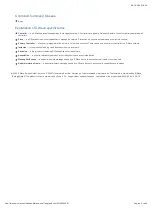
06-10-2020 16
:
42
Pagina 3 van 5
http://manual.zwave.eu/backend/make.php?lang=en&sku=POPE004407
CO level above 150 ppm for a duration of 2 minutes
The alarm will be sent to the central controller. Additionally, the alarm can be used to switch any other Z-Wave controllable actuator such as a Switch, a Dimmer o
even a Door Lock that is placed in association group 2. The wireless module will also report a low (wireless module) battery warning. Please note that the battery
of the main detector is not reported since this battery can?t be replaced anyway.
Support for Command Class BASIC
The device supports the generic Z-Wave command class BASIC. The device will ignore any SET command but return the status of the sensor on a GET comman
(triggered=0xff, idle=0x00).
Alarm Messages
The device will issue the following (unsolicited) alarm messages:
CO Danger Detected (this message will also be issued when the test button is pressed)
Low Battery Alarm (when the battery of the wireless modules goes low)
Tamper Detected (ON, when the CO detector head is removed from the base; OFF, when the detector head is mounted to the base)
Malfunction (issued, when the detector main head detects a malfunction of CO detection)
Node Information Frame
The Node Information Frame (NIF) is the business card of a Z-Wave device. It contains information about the device type and the technical capabilities. The inclu
and exclusion of the device is confirmed by sending out a Node Information Frame. Beside this it may be needed for certain network operations to send out a No
Information Frame. To issue a NIF execute the following action: Single Click the Z-Wave Button on the bottom side module
Communication to a Sleeping device (Wakeup)
This device is battery operated and turned into deep sleep state most of the time to save battery life time. Communication with the device is limited. In order to
communicate with the device, a static controller
C
is needed in the network. This controller will maintain a mailbox for the battery operated devices and store
commands that can not be received during deep sleep state. Without such a controller, communication may become impossible and/or the battery life time is
significantly decreased.
This device will wakeup regularly and announce the wakeup state by sending out a so called Wakeup Notification. The controller can then empty the mailbox.
Therefore, the device needs to be configured with the desired wakeup interval and the node ID of the controller. If the device was included by a static controller th
controller will usually perform all necessary configurations. The wakeup interval is a tradeoff between maximal battery life time and the desired responses of the
device. To wakeup the device please perform the following action: Single Click the Z-Wave Button on the bottom side module
Quick trouble shooting
Here are a few hints for network installation if things dont work as expected.
1. Make sure a device is in factory reset state before including. In doubt exclude before include.
2. If inclusion still fails, check if both devices use the same frequency.
3. Remove all dead devices from associations. Otherwise you will see severe delays.
4. Never use sleeping battery devices without a central controller.
5. Dont poll FLIRS devices.
6. Make sure to have enough mains powered device to benefit from the meshing
Firmware-Update over the Air
This device is capable of receiving a new firmware 'over the air'. The update function needs to be supported by the central controller. Once the controller starts th
update process, perform the following action to confirm the firmware update: Once the firmware update process has started (wakeup first by single push of the Z-W
button) double click the Z-Wave button to confirm firmware update process.
Association - one device controls an other device
Z-Wave devices control other Z-Wave devices. The relationship between one device controlling another device is called association. In order to control a different
device, the controlling device needs to maintain a list of devices that will receive controlling commands. These lists are called association groups and they are alw
related to certain events (e.g. button pressed, sensor triggers, ...). In case the event happens all devices stored in the respective association group will receive th
same wireless command wireless command, typically a 'Basic Set' Command.
Association Groups:
Group Number
Maximum Nodes
Description
1
10
Lifeline
2
10
Switching Command when Alarm
Configuration Parameters
Z-Wave products are supposed to work out of the box after inclusion, however certain configuration can adapt the function better to user needs or unlock further
enhanced features.
IMPORTANT:
Controllers may only allow configuring signed values. In order to set values in the range 128 ... 255 the value sent in the application shall be the de























